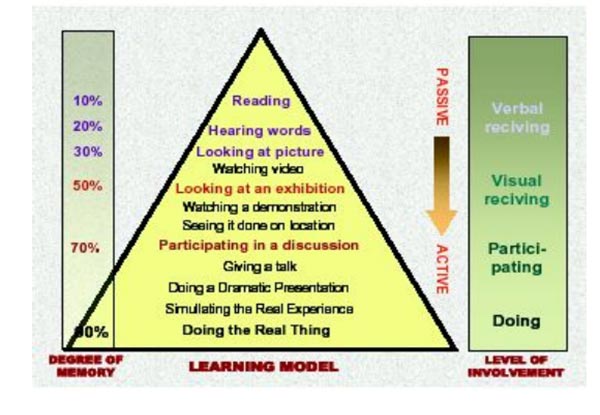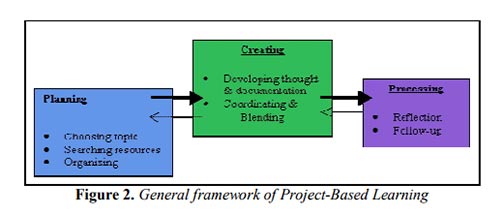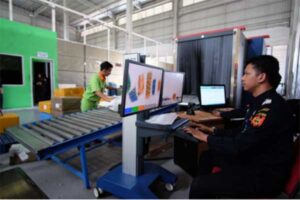
A number of reports have raised about how to prepare tomorrow’ teachers. As we know in orienting TVET for sustainable development that the economic imperative needs to increase levels of productivity through widespread of technology and knowledge.
It needs skilled workers in transformed, high performance workplaces, which require all workers to understand problem, contribute solution, be adaptable and new skills, measure quality on regular basis, and learn from mistakes.
Lynch (2000) recommend to teach all students to new levels of higher order thinking, to teach youth how to think, not just what to think, to think critically, to think creatively, make decisions, solve problems, visualize a solution, reason, analyze, interpret and how to continue to learn.
On the other hand for prepared pre service teacher in TVET we should focus on developing they are for new roles as leaders, to focus not on disciplines, but rather on contextual relationships between subject matter and integrated work based contexts meaningful to students at the time.
Research shows that learners not only respond by feeding back information, but they also actively use what they know to explore, negotiate, interpret, and create. Figure 1 show that active learner who active in teaching and learning process will be knowledgeable more than passive learner.
Definition of Project-based learning
Project-based learning, or Group Investigation (Sharan, 1998) is a form of cooperative learning that contextualizes learning by presenting learners with problems to solve or products to develop (Katz, 1994). In another definitions Project-Based Learning is a comprehensive instructional approach to engage learners in sustained, cooperative investigation (Bransford & Stein, 1993).
Project-Based Learning is a teaching and learning strategy that engages learners in complex activities. It usually requires multiple stages and an extended duration–more than a few class periods and up to a full semester. Projects focus on the creation of a product or performance, and generally call upon learners to choose and organize their activities, conduct research, and synthesize information.
According to current research (Thomas, Mergendoller, & Michaelson, 1999; Brown & Campione, 1994; http://www.ed.gov), projects are complex tasks, based on challenging questions, that serve to organize and drive activities, which taken as a whole amount to a meaningful project.
They give learners the opportunity to work relatively autonomously over extended periods of time and culminate in realistic products or presentations as a series of artifacts, personal communication, or consequential tasks that meaningfully address the driving question. PBL environments include authentic content, authentic assessment, teacher facilitation but not direction, explicit educational goals, collaborative learning, and reflection.
Education has benefited, if teachers have learned how to effectively select content and activities to amplify and extend the skills and capabilities of students. More important than the definition it self are the attributes of effective projects based learning. Outstanding projects based learning:
- Recognize students’ inherent drive to learn, their capability to do important work, and their need to be taken seriously by putting them at the center of the learning process
- Engage students in the central concepts and principles of a discipline. The project work is central rather than peripheral to the curriculum
- Highlight provocative issues or questions that lead students to in-depth exploration of authentic and important topics.
- Require the use of essential tools and skills, including technology, for learning, selfmanagement, and project management
- Specify products that solve problems, explain dilemmas, or present information generated through investigation, research, or reasoning.
- Include multiple products that permit frequent feedback and consistent opportunities for students to learn from experience.
- Use performance-based assessments that communicate high expectations, present rigorous challenges, and require a range of skills and knowledge.
- Encourage collaboration in some form, either through small groups, student-led presentations, or whole-class evaluations of project results.
Components of Project-Based Learning
Seven features can be identified as key components of Project-Based Learning. These features can be used in describing, assessing, and planning for projects. They are:
Learner-centered environment:
This component is designed to maximize student decisionmaking and initiative throughout the course of the project including topic selection to design, production, and presentation decisions. Projects should include adequate structure and feedback to help learners make thoughtful decisions and revisions. By documenting learners’ decisions, revisions, and initiative, teachers (and learners) will capture valuable material for assessing student work and growth.
Collaboration:
This component is intended to give learners opportunities to learn collaborative skills, such as group decision-making, interdependence, integration of peer and mentor feedback, providing thoughtful feedback to peers, and working with others as student researchers.
Curricular content:
Successful integration of content requires projects to be based on standards, to have clearly articulated goals, and to support and demonstrate content learning both in process and product.
Authentic tasks:
This element can take on many forms, depending on the goal of the project. PBL may connect to the real world because it addresses real world issues that are relevant to learners’ lives or communities. A project may be connected to real professions through the use of authentic methods, practices, and audiences. Communicating with the world outside the classroom, via the Internet or collaboration might also make real world connections with community members and mentors.
Multiple presentation modes:
This component gives learners opportunities to effectively use various technologies as tools in the planning, development, or presentation of their projects. Though the technology can easily become the main focus of a given project, the real strength of the multimedia component lies in its integration with the subject curriculum and its authentic use in the production process.
Time management:
It builds on opportunities for learners to plan, revise and reflect on their learning. Though the time frame and scope of projects may vary widely, they should all include adequate time and materials to support meaningful doing and learning.
Innovative assessment:
Just as learning is an ongoing process, assessment can be an ongoing process of documenting that learning. PBL requires varied and frequent assessment, including teacher assessment, peer assessment, self-assessment, and reflection. Assessment practices should also be inclusive and well understood by learners, allowing them opportunities to participate in the assessment process in ways not typically supported by more traditional teacher-centered lessons.
The basic phases found in most projects include selecting a topic, making plans, researching, developing products, and sharing results with others. Students cooperate in carrying out their investigation, in planning how to integrate and present their findings, and in evaluating their own and interpersonal effort (Sharan, 1998).
Project work, it is generally claimed, allows for taking initiative and assuming responsibility, making decisions and choices, and pursuing interests. A further important aspect is the social learning experiences it affords, such as peer teaching and group construction of knowledge, which allow student to observe – and emulate -other models of successful learning. Generally, three phases can be suggested in conducting Project-Based Learning: planning, creating and implementing, and the processing.

Figure 2 represents. PBL can be divided into three main processes. In the planning phase, the learner chooses the topic, searches for resources for needed information, and organizes the resources into an usable form. In the implementation or creation phase, the learner develops the project idea, combines the contributions of the group, and builds the project. In the processing phase, the project is shared with other groups, feedback is obtained, and then the groups reflects on the project.
Project-Based Learning offers many advantages and challenges when implemented in the classroom. Purnawan (2007) found that the project based learning in technical education increasing student motivation, student more critical, more cooperate and advances to communication ability. However, there are strategies to successfully meet these challenges. Some of the advantages in PBL learning include but are not limited to:
1. Increased motivation:
Learners can choose their topics, the extent of content, and the presentation mode. Learners build their projects to suit their own interests and abilities. These kinds of activities are highly motivating for learners.
2. Increased problem-solving ability:
Project-Based Learning encourages learners to engage in complex and ill-defined contexts. From the beginning, learners identify their topics and problems, then seek possible solutions. By participating in both independent work and collaboration, learners improve their problem solving skills thereby developing their critical thinking skills.
3. Improved media research skills:
Project-Based Learning provides a real world connection to context. Learners conduct research using multiple information resources. By locating the resources themselves, their research skills develop and improve.
4. Increased collaboration:
In the processing stages, learners create and organize their groups. They share knowledge and collaboratively construct artifacts. Through collaboration, they develop social communication skills and obtain multiple perspectives.
5. Increased resource-management skills:
Successful Project-Based Learning provides learners with experience in project organization and time management with necessary scheduling resources.
As with any instructional strategy, Project-Based Learning presents some challenges. The following highlights some challenges of a PBL environment:
Support of student learning: Teachers may be unprepared to implement activities for Project-Based Learning due to a lack of familiarity with this pedagogy. They must stimulate discussion through open-ended questions that facilitate creative thinking. Instructors should also encourage learners to find answers independently from resources rather than simply “feeding” them information.
Assessment: Evaluating academic performance in a Project-Based Learning environment is problematic for instructors. Evaluation of learners’ knowledge acquisition is difficult because individual contributions can seldom be identified with certainty. Several strategies are available for evaluating learner achievement, such as individual or group self-evaluation, or comparison between student performance and class objectives. The process of assessment should also address how the learners share the responsibility of peer-work.
Implemented Project Based Learning
Advice to teacher who implemented project based learning as teaching learning model (www.techlearning.com) ;
- More than an end product. The project is more than just the final product, it is all of the pieces: the lesson plans, the activities, the assessments, and even the tests and quizzes.
- Start with what you already are doing. Don’t throw away all the great lessons you’ve used in the past. If your existing lessons help students acquire the skills and concepts necessary for the project, then use them.
- Begin and end with the standards. Students master the standards when they can apply the skills and concepts they learn. One effective way to check for mastery is to use rubrics to look at performance. Focus only on five to six standards.
- Focus on assessments. Use two types of assessment: formative and summative. Formative assessment occurs throughout the project and is used to make sure that students understand skills and concepts; these tests, observations, and student work serve as diagnostic tools. Summative assessments happen at the end of the project and allow students to apply and demonstrate what they have learned.
- Make it fun. Project work should be fun and motivating. Whenever possible, provide real-world problems for students to solve
General framework of Project-Based Learning – Temporaktif Education






